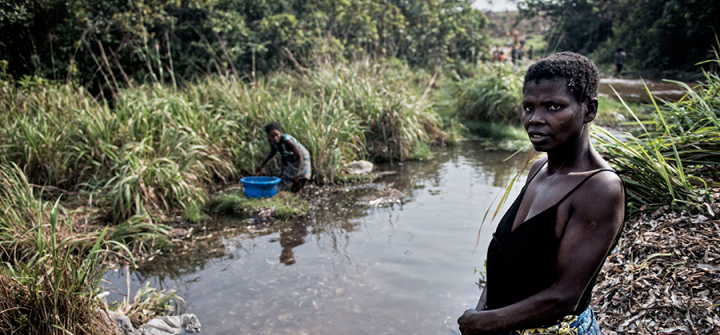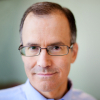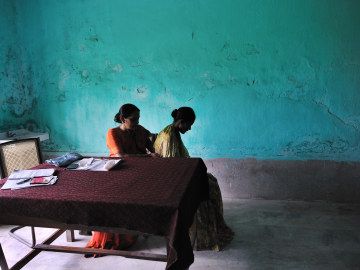Konzo: Don't Look Away
While global attention flutters from conflict to outbreaks, the impoverished people of Kahemba, Democratic Republic of Congo, and many other towns live in chronic crisis.
Grinding poverty leaves them malnourished and dependent on a type of cassava that thrives in dry conditions but also harbors cyanide that leads to polio-like paralysis and possibly cognitive impairment when sources of protein aren’t available. Perhaps 100,000 people in the DRC alone have been afflicted by the disease known as konzo. No one knows for sure how many there or across Africa are afflicted.
In the face of this perpetual tragedy, the world looks away. That must stop.
Science journalist Amy Maxmen’s konzo series in Global Health NOW makes two very clear points: Konzo is a horror for the poorest of the poor; and action must be taken now.
In Kahemba, known as the “place of suffering,” konzo’s victims rely on makeshift crutches, wheelchairs made from lawn chairs and bicycle tires, or handheld blocks that they use to crawl through city’s dirt streets. They suffer from konzo because they are poor and had nothing else to eat but the bitter cassava. Most will remain poor because konzo takes away their potential to farm or otherwise work to support their families.
The most grotesque aspect of the cruelty visited upon konzo’s victims: It doesn’t have to be this way.
With modest support from the global community, there are short-term and long-term solutions that can break the konzo-poverty cycle and safeguard future generations.
First, a mass media education campaign on the evidence-based “wetting method” needs to be deployed to help affected populations. Soaking the bitter cassava in water for several days can detoxify the plant, but hungry people can’t wait days to eat nor can they risk someone stealing their cassava as it soaks in a river. In contrast, the wetting method, developed by Australian chemist Howard Bradbury, requires only a few hours. By pounding cassava into flour and mixing it with water, people can detoxify the flour by 3- to 6-fold in a matter of hours. Desire Tshala-Katumbay, a Congolese-born physician and neurotoxicologist with the Oregon Health & Science University and one of the few scientists working on konzo, has a grant from the US National Institute of Environmental Health Sciences and the Fogarty International Center to educate community leaders on the wetting method but much more needs to be done.
Second, governments and international donors need to address konzo outbreaks before they happen. They can be at least partially predicted since they fluctuate with rainfall. During dry periods, konzo cases increase because the drought-resistant cassava is one of the few plants that survive. Direct cash assistance (currently being used to help refugees) and other strategies need to be explored as means for improving dietary options during droughts.
Third, the paucity of epidemiological data on konzo must be addressed. As has often been noted, you can’t solve a problem unless you can measure it. Current official data put konzo cases in Africa at around 11,000 but these are believed to be massive underestimates.
Each konzo victim is a human being who deserves to be counted.
Fourth, active surveillance needs to be implemented. Tshala is working on a project to get kits into the field that can measure traces of cyanide in cassava flour and its metabolites in urine. These kind of data can be used to prioritize interventions to the most at-risk areas.
Those are immediate needs but konzo demands other action. Research into cognitive impairment—another possible result of bitter cassava consumption—is a critical long-term need. Tshala and colleagues believe that poor children who don’t have physical symptoms may still suffer from impaired memory and cognitive ability. In addition, agricultural reform (including access to better land for farming and other measures) and assistance in development of other drought-resistant crops would lessen konzo’s impact.
Finally, most difficult of all: The prevalence of deep, persistent poverty must be addressed. As famed Swedish researcher Hans Rosling told Maxmen, “All konzo communities are identical in extreme poverty.” It’s axiomatic that konzo victimizes the poor, those who have no choice but to eat poisonous cassava or starve.
It’s also a fundamental tenet for humanity that the most vulnerable, the most marginalized deserve protection and support.
It is time for the world to start paying attention to konzo and the people it afflicts.
Brian W. Simpson, MPH, is editor-in-chief of Global Health NOW.
Join the thousands of subscribers who rely on Global Health NOW summaries and exclusive articles for the latest public health news. Sign up for our free weekday enewsletter, and please share the link with friends and colleagues: Subscribe to GHN





